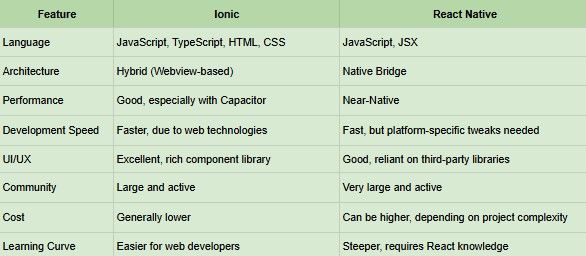Home
Services
Products
Projects
Who We Are
Blogs
Contact Us

React Native vs. Ionic: Choosing the Right Framework for Your Mobile App
Developing a mobile app involves more complex decisions than just design, features, and cost. A crucial factor is selecting the right framework. Platforms like Flutter, React Native, Ionic, Angular, and even Node.js and PHP offer diverse capabilities, each excelling in different areas. This article delves into a detailed comparison of two leading contenders: React Native and Ionic.
Previously, we've explored Flutter vs. React Native and React Native vs. Hybrid apps. Now, we focus on React Native and Ionic, dissecting their strengths and weaknesses to help you make an informed decision.
React Native, developed by Facebook, leverages JavaScript, the most widely used programming language among developers, along with popular frameworks like Vue.js and React.js. Ionic, created by Drifty in 2013, utilizes TypeScript. Its latest stable release is Ionic 7.
Understanding Ionic
Ionic is an open-source framework for hybrid app development, employing JavaScript, CSS, and HTML5. It prioritizes the look, feel, and UI of the app. By combining Apache Cordova and Angular/Stencil/React/Vue (depending on the chosen web framework), Ionic provides a robust foundation for building cross-platform applications, including Progressive Web Apps (PWAs). Ionic offers developers familiar web technologies (Sass, HTML5, and CSS) to create apps deployable across Android, iOS, and Windows platforms.
Benefits of Ionic:
- Cross-platform Deployment: Develop once, deploy across Android, iOS, and Windows.
- Web Technologies: Leverage familiar web technologies like HTML5, JavaScript, and CSS.
- UI-Centric: Focuses on delivering a polished and engaging user interface.
- Rich Component Library: Provides pre-built UI elements for faster development.
Key Features of Modern Ionic:
- Web Components: Ionic utilizes web components for enhanced performance and modularity. These reusable HTML tags improve load times and startup performance.
- Stencil: This web component compiler supports various JavaScript frameworks (React, Preact, etc.) and provides access to Virtual DOM, TypeScript, and JSX.
- Capacitor/Cordova: These tools bridge web technologies and native device functionalities, enabling access to device features like camera, GPS, and more.
Understanding React Native
React Native enables the creation of native-like apps for specific operating systems using JavaScript. It allows for significant code reusability, reducing development time and effort. This cross-platform capability makes it attractive for businesses seeking efficient development for both Android and iOS.
Benefits of React Native:
- Code Reusability: Write code once and deploy it on both Android and iOS.
- Native Performance: Offers near-native performance due to its bridge to native components.
- Large Community: Benefits from a large and active community providing ample support and resources.
- Continuous Improvement: Regular updates and improvements enhance the framework's capabilities.
Features of React Native:
- Cost-Effective: Code reusability contributes to lower development costs.
- Virtual DOM: Facilitates real-time updates and efficient rendering.
- Strong Community: Large community support fosters knowledge sharing and problem-solving.
- Open Source: Allows developers to inspect, learn from, and contribute to the codebase.
Ionic vs. React Native: A Detailed Comparison

Choosing the Right Framework
Both Ionic and React Native are powerful frameworks, each with its strengths and weaknesses. The best choice depends on the specific project requirements:
Choose Ionic if:
- Budget is a primary concern.
- Cross-platform compatibility is crucial, including web and PWA support.
- Rapid development and a polished UI are priorities.
- Your team has strong web development skills.
Choose React Native if:
- Near-native performance is essential.
- Access to native device features is critical.
- The project demands complex animations and interactions.
- Your team has experience with React.
Conclusion
While both frameworks offer compelling advantages, React Native often emerges as the preferred choice for projects demanding high performance, a native look and feel, and complex functionalities. Its robust community, frequent updates, and access to native APIs make it a powerful solution for building sophisticated mobile applications. However, Ionic remains a strong contender for projects where budget and development speed are paramount, particularly when leveraging its rich UI component library and cross-platform capabilities. DEFX, as a leading IT services provider, possesses expertise in both frameworks and can assist you in selecting the optimal solution for your unique project needs.
See More
Contact Us
Let’s make your Idea into Reality
Let's Talk
© Copyright DEFX. All Rights Reserved
GoodFirms ★ 4.2
Clutch ★ 4.2
Google ★ 4.2
